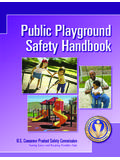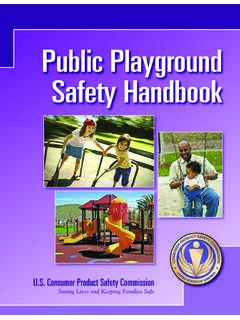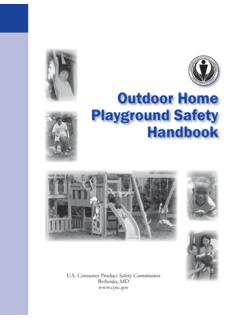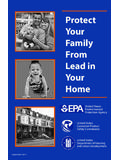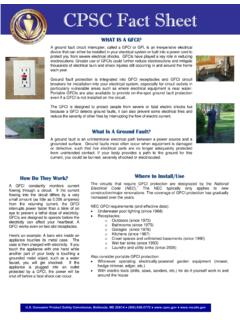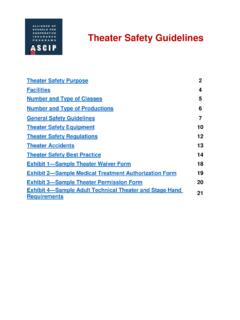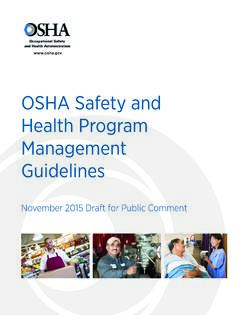Transcription of Safety Barrier Guidelines for Residential Pools
1 Safety Barrier Guidelines for Residential PoolsPreventing Child Consumer Product Safety CommissionThis document is in the public domain. Therefore it may be reproduced, in part or in whole, without permission by an individual or organization. However, if it is reproduced, the Commission would appreciate attribution and knowing how it is further information, write: Consumer Product Safety Commission Office of Communications 4330 East West Highway Bethesda, Md. 20814 is charged with protecting the public from unreasonable risks of injury or death associated with the use of the thousands of consumer products under the agency s Barrier Guidelines for Residential Pools 1 Each year, thousands of American families suffer swimming pool trage-dies drownings and near-drownings of young children.
2 The majority of deaths and injuries in Pools and spas involve young children ages 1 to 3 and occur in Residential settings. These tragedies are Consumer Product Safety Commission (CPSC) booklet offers Guidelines for pool barriers that can help prevent most submersion incidents involving young children. This handbook is designed for use by owners, purchasers, and builders of Residential Pools , spas, and hot swimming pool Barrier Guidelines are not a CPSC standard, nor are they mandatory requirements. CPSC believes that the Safety features recommended in this booklet will help make Pools safer, promote pool Safety awareness, and save lives. Barriers are not the sole method to prevent pool drowning of young children and cannot replace adult states and localities have incorporated these Guidelines into their building codes.
3 Check with your local authorities to see what is required in your area s building code or in other communities have enacted Safety regulations for barriers at resi-dential swimming Pools in ground and above ground. In addition to following these laws, parents who own Pools can take their own precau-tions to reduce the chances of their youngsters accessing the family or neighbors Pools or spas without supervision. This booklet provides tips for creating and maintaining effective barriers to Pools and Safety Barrier Guidelines for Residential PoolsSwimming Pool Barrier GuidelinesMany of the nearly 300 children under 5 who drown each year in backyard Pools could be saved if homeowners completely fenced in Pools and installed self-closing and self-latching devices on gates.
4 Anyone who has cared for a toddler knows how fast young children can move. Toddlers are inquisitive and impulsive and lack a realistic sense of danger. These behaviors make swimming Pools particularly hazardous for households with young children. CPSC reports that child drownings are the second leading cause of accidental death around the home for children under 5 years of age. In some southern or warm weather states, drowning is the leading cause of accidental death in the home for children under 5. CPSC staff has reviewed a great deal of data on drownings and child behavior, as well as information on pool and pool Barrier construction. The staff concluded that the best way to reduce child drownings in Residential Pools is for pool owners to construct and maintain barriers that will help to prevent young children from gaining access to Pools and spas.
5 The Guidelines provide information for pool and spa owners to use to prevent children from entering the pool area unaccompanied by a supervising adult. They take into consideration the variety of barriers (fences) available and where each might be vulnerable to a child wanting to get on the other swimming pool Barrier Guidelines are presented with illustrated descriptions of pool barriers. The definition of pool includes spas and hot tubs. The swimming pool Barrier Guidelines therefore apply to these structures as well as to above ground Pools , and may include larger portable Barrier Guidelines for Residential Pools 3 Pool and Spa Submersions: Estimated Injuries and Reported Fatalities*CPSC publishes an annual report on submersion incidents.
6 Key findings from the 2012 report include: nNearly 300 children younger than 5 drown in swimming Pools and spas each year representing 75 percent of the 390 fatalities reported for children younger than 15. nChildren aged 1 to 3 years (12 months through 47 months) represented 67 percent of the reported fatalities and 66 percent of reported injuries in Pools and spas. nOver 4,100 children younger than 5 suffer submersion injuries and require emergency room treatment; about half are seriously injured and are admitted to the hospital for further treatment. nThe majority of drownings and submersion injuries involving victims younger than 5 occur in Pools owned by the family, friends or relatives.
7 NThe majority of estimated emergency department-treated submersion injuries and reported fatalities were associated with Pools . nPortable Pools accounted for 10 percent of the total fatalities (annual average of 40) for children younger than 15. *The report presents average annual estimates for emergency department-treated injuries for 2009 through 2011 and average annual estimates for fatal submersions for 2007 through 2009, as reported to CPSC staff. The years for reported injury and fatality statistics differ due to a lag in fatality Safety Barrier Guidelines for Residential PoolsBarriersBarriers are not child proof, but they provide layers of protection for a child when there is a lapse in adult supervision.
8 Barriers give parents additional time to find a child before the unexpected can include a fence or wall, door alarms for the house, and a power Safety cover over the pool. Use the following recommendations as a LocationsBarriers should be located so as to prohibit permanent structures, equipment or similar objects from being used to climb the A fence completely surrounding the pool is better than one with the house serving as the fourth side. Fences should be a minimum of 4 feet high, although fences 5 feet or higher are preferable. If the home serves as one side of the Barrier install door alarms on all doors leading to the pool area. Make sure the doors have self-closing and self-latching devices or locks beyond the reach of children to prevent them from opening the door and gaining access to the pool.
9 Pool covers add another layer of protection and there are a wide variety of styles on the market. Keep pool covers well-maintained and make sure the control devices are kept out of the reach of Barrier Guidelines for Residential Pools 5 How To Prevent a Child from Getting OVER a Pool BarrierA young child can get over a pool Barrier if the Barrier is too low or if the Barrier has handholds or footholds to use when climbing. The top of a pool Barrier should be at least 48 inches above grade, measured on the side of the Barrier which faces away from the swimming pool. Some states, counties or municipalities require pool barriers of 60 inches. Eliminate handholds and footholds and minimize the size of openings in a Barrier s a Solid BarrierNo indentations or protrusions should be present, other than normal construction tolerances and masonry "4"4"Equal to or more than 45"A successful pool Barrier prevents a child from getting OVER, UNDER, or THROUGH and keeps the child from gaining access to the pool except when supervising adults are 1 Figure 26 Safety Barrier Guidelines for Residential PoolsFor a Barrier (Fence)
10 Made Up of Horizontal and Vertical MembersIf the distance between the top side of the horizontal members is less than 45 inches, the horizontal members should be on the swimming pool side of the fence. The spacing between vertical members and within decorative cutouts should not exceed 1 inches. This size is based on the foot width of a young child and is intended to reduce the potential for a child to gain a foothold and attempt to climb the fence. If the distance between the tops of the horizontal members is more than 45 inches, the horizontal members can be on the side of the fence facing away from the pool. The spacing between vertical members should not exceed 4 inches.


